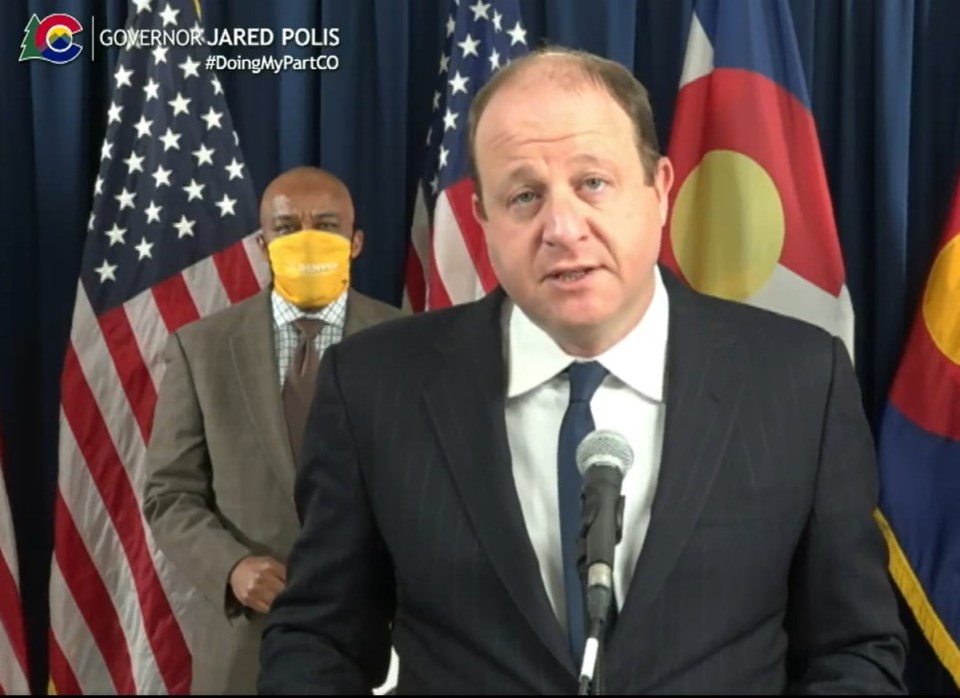Boulder County is one of 15 counties that will move to the new red status on the state's COVID dial dashboard on Friday.
The newly created red status brings with it a host of more stringent health guidelines and is just a step away from a new purple status that calls for another shutdown to stop the spread of the coronavirus.
Under the Safer at Home Level Red status, restaurants are closed to indoor dining, and outdoor dining is limited to groups from the same household.
Last call is moved to 8 p.m. and bars must close.
Gyms, retailers, manufacturers, offices, event venues and places of worship must cut their capacities.
Child care facilities remain open and in-person learning is suggested, with hybrid or remote options “as appropriate,” for prekindergarten through middle school. Hybrid or remote is suggested at the high school level.
Level Red status also calls for no personal gatherings of any size.
The change to the dial, which takes effect Friday, was announced at a Tuesday news conference featuring Gov. Jared Polis, Denver Michael Hancock, and state legislative leaders Sen. Leroy Garcia and Rep. Alec Garnett.
The counties impacted were announced later in the day by the Colorado Department of Public Health and Environment.
“It’s clear from the data that what we have been doing hasn’t worked well enough,” Polis said, calling for a “a more drastic shift” in behavior.
He urged people to stay home as much as possible in the next few weeks, to avoid interacting with others from outside their households, to wear masks when they do go out and to frequently wash their hands to stop the exponential spread of the virus in order to save lives and the economy.
“These are not easy steps to take … but we must act now to save lives” and avoid another lockdown, he said.
The dial system assigns colors to counties based on positivity rate, cases per 100,000 people and hospital capacity. A move to red status is based on a positivity rate of 15% or higher, a two-week incidence of more than 350 cases per 100,000 population, and COVID hospital admissions of more than two on any given day in a 14-day period, according to a guide published by CDPHE.
The key distinction between red and purple on the dial is hospital capacity, with counties moving into purple status when hospitals are overwhelmed, Polis said.
More people are hospitalized now because of coronavirus than there were in March and April at the onset of the pandemic, and hospitals are starting to feel the strain, he said.
As of Tuesday, one in every 110 Coloradans is contagious with the coronavirus, Polis said. Statewide cases totaled 167,713 as of Tuesday, according to Colorado Department of Public Health and Environment data. Hospitalizations stood at 11,203 Tuesday, while deaths among those with COVID totaled 2,578 and deaths caused by COVID totaled 2,276, according to state data.
In Boulder County, 8,910 residents have tested positive for COVID, 299 are hospitalized and the number of people who died with COVID totaled 108 on Tuesday, according to county data.
In Longmont, 2,563 people had tested positive or were considered probably for the virus as of Monday, according to the county data.
Getting as many students back into the classroom, particularly those in kindergarten through fifth grades, which is allowed under the red status, also was among the things Polis’ stressed at the news conference. The state is working to ensure school districts have what they need to keep in-person learning safe and said additional funding for classrooms, personal protective equipment and other needs could be announced in the coming days.
That focus on in-person learning was met by pushback from the Colorado Education Association. In an emailed statement, CEA President Amie Baca-Oehlert praised Polis’ focus on funding for school needs and his calling a special legislative session to address coronavirus relief, but not for keeping or bringing younger students into the classroom.
“We are disappointed... that at the same time Gov. Polis describes dangerous levels of exponential growth of the virus, he says that K-5 students should attend class in person. Most counties have no specific community mitigation strategies in place to slow the community spread so that schools can open safely for students and educators,” she said in the statement. “As community spread increases, it becomes increasingly difficult for schools to maintain appropriate staffing levels to remain open. …”
She also called for the state to provide “clear and specific thresholds and metrics that will help school districts make decisions and provide transparency and predictability for parents and families about how decisions regarding safe in person or remote learning are made.”



